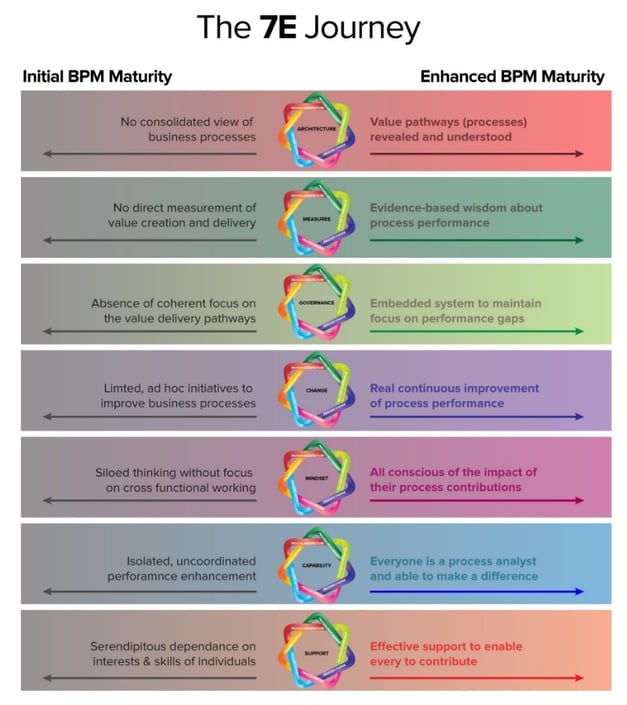The Process Session is a weekly video series posted on The Leonardo Blog that discusses all things BPM and Enterprise Architecture.
Today, Marco talks about Process Support.
Please let us know if you have any ideas for future topics for The Process Session.
Video Transcription - Process Support
Thanks for joining me again for The Process Session. Today, we’re talking about the last enabler of the 7 Enablers of Business Process Management – Process Support.
Over the past few weeks we’ve discussed process architecture – the key artefact that stores our business process which delivers value to our clients. We want to put in place some key measures – the second enabler – to ensure we are achieving what we have set out to achieve for that process. We also put some governance in place – we have a process owner who sets these measurement targets, responds to them accordingly and continues that loop on a daily, weekly or monthly basis. When there is a change, they put that into a process improvement cycle where the process is then improved. When that takes place, we have a lot of change in the organization - both to systems and people. So we need to understand how to manage that within the process improvement cycle. In order to do that, we need to make sure the mindset and culture of the organisation is receptive and ready for change. We then build from there build the capability within our people and our systems to be able to achieve the remainder of the seven enablers.
So today we’re going to talk about Process Support. The support of all of the above is extremely important. You will often need a central office (Office of BPM), group or team that orchestrates and coordinates this information.
Manage BPM Strategy
The way we’ve pictured this is that we have to have our own strategy in place. We need to eat our own food and products as it were; we need to have our own architecture in place to do the process of process improvement or process management. So we set a strategy to align with the organizations strategy and deliver on this.
We do so by ensuring we have proper methods and systems in place. We have to have our management processes in place to help support this team/office and support the organization. We need to be able to deliver the process improvement methodologies. We also need to support this office. It doesn’t have to be big! I can be done with a small number of people and in some organizations it can be achieved with part of a role. As your organization grows, so too must this grow either using a centralized or decentralized model.
Support Process Management
We come with the organization strategy front of mind and we need to filer all of the strategic demands and operational demands and shift them into a project portfolio. The project needs to determine which projects (with our limited resources) we can address first. That then funnels into process improvement projects that we deliver upon.
Supporting Process Improvement
We need to understand what process improvement methodologies we want to use. We want to be sure that if we use 6 sigma, we’re ready and enabled to deliver this through the organization. The management office shouldn’t be the place where everything gets done – it is the place that orchestrates the everything being done within the business. To what extent we have trained people in and outside the office depends on the culture of the organisation, what is trying to be achieved and which projects we’re trying to deliver on. In this space we’re wanting continuous improvement, to move from a ‘as-is’ to a better ‘as-is’ – a business better than usual situation. We do this using various techniques of lean, six-sigma or any other methods to get there.
Support of the Office of BPM
In the final part of this process office is the support, where the tools and methodologies that enable this effectively and efficiently come from. We need to understand:
- how big this is going to be so we can manage the roles and responsibilities .
- the budget required; how to we make money and save money within a function of this. We have services that need to managed in an efficient and effective way.
That is effectively the support enabler that ensures all the other process enablers (architecture, measurement, governance, mindset, change, capability) ties together to deliver process improvement.
So what if don’t have any of these seven enablers? What are the end results if we don’t have any one of the seven enablers operating properly.

- If we don’t have a process architecture – then we’re looking towards disharmony because we don’t understand how our business processes really link together
- If we don’t have measurement in place and a measurement method that is properly implemented – then it is guesswork we’re doing in our business
- If we don’t have a governance structure in place – then we’re looking towards anarchy
- If we don’t have change put in place at the beginning – then it is futility
- If we don’t have the right mindset – then we’re looking at disunity within the people, within the organization
- If we don’t have the right capability enabled – then we will end up with frustration
However when you have all seven operating together, harmoniously, orchestrated very well by a central office (OBPM) then and only then will you have true transformation.




